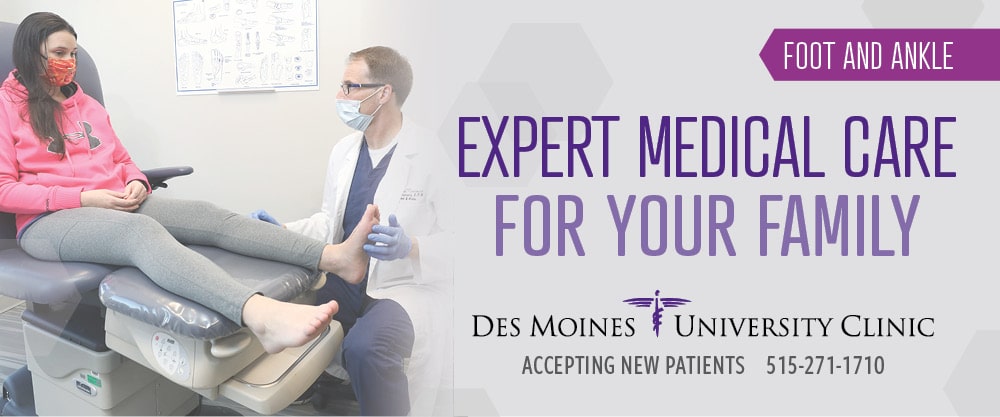The information in this post was adapted from the above Mini-Medical School presentation that was recorded in February 2022. Dr. Allen Kempf is an assistant professor in the College of Podiatric medicine and surgery at Des Moines University and a practicing physician in the Des Moines University Clinic.
What is diabetes?
Diabetes is a metabolic disease of inadequate control of blood glucose or blood sugar. There are two main types of diabetes. The first one is type one diabetes, and that’s a defect in the way that our body secretes insulin. The second type is type two diabetes and that’s a defect in insulin action.
Diabetes Pathophysiology
Pathophysiology is the non-functioning normal mechanism that occurs within a disease process, in this case diabetes. When we think about diabetes, we often think about the term insulin. Insulin is created in our pancreas. The pancreas has what are called beta cells that make, store, and release insulin into the bloodstream. Insulin has many functions, but we are going to focus on its role of bringing glucose out of the blood, into the cells, so the cells can use it to make energy.
Pathology occurs when this fails to function correctly. In normal physiology, our pancreas releases insulin happily through its beta cells. The insulin travels through the blood, finds its receptor and acts sort of like a light switch for the cell. As this binds to the receptor, it activates the cell to stimulate glucose transport, and glucose is then brought into the cell through the transporter to be broken down and used for energy. In type one diabetes we have an auto-immune disruption of the beta cells. The immune system attacks the cells, and we have a decreased production of insulin. When we decrease the amount of insulin, we have decreased insulin binding to the insulin receptor, the switch doesn’t get turned on and the glucose is not able to go through the transporter and remains in the blood. We then have high blood sugar because the glucose (or the sugar itself) can’t be brought into the cell because the insulin is not binding to the receptor. We also see that with type two diabetes, insulin is released because we don’t necessarily have the immune response attacking the beta cells. But as insulin is released, we have insulin resistance.
The insulin doesn’t find its receptor. As the blood sugar increases, your body tries to make more receptors and eventually it gets tired and burns out. When that happens, you have a decreasing amount of available insulin receptors. And so, it’s unable to bind insulin as frequently. And by doing that, you have a decreased amount of sugar that’s being brought into the cell.
Why does that matter: the Epidemiology of Diabetes
Globally, one in 11 adults has diabetes. 90% of those are type two diabetes. The prevalence (or the total number of cases) is expected to increase from 415 million to 642 million by 2040. So, in about 18 years, we’ll have another 200 million patients. If we look at the United States by itself, we have 37 million people with diabetes, so roughly 11% of our current population. One in five of those don’t know that they’re diabetic. And that’s where some of the complications arise.
A lot of patients don’t realize that they have diabetes because they don’t recognize the symptoms, or they haven’t been diagnosed. 96 million people in United States have pre-diabetes, which ultimately can (without lifestyle changes) lead to diabetes. 84% of those 96 million don’t know that they’re pre-diabetic. It’s very common that people are falling into these categories (pre-diabetic or diabetic) which increases their risk for complications down the road.
Type two diabetes in the United States accounts for 90 to 95% of all the cases that are diagnosed. Globally, type two diabetes is the most common type. It’s currently the seventh leading cause of death in the United States.
Risk factors for developing diabetes
If you are pre-diabetic this increases your risk of developing diabetes. Being overweight has been associated with diabetes formation. It has to do with increased glucose that is in the blood and our receptors ability to respond to that.
We see a higher risk in individuals 45 years of age or older. As we have more birthdays in life, we tend to be more susceptible to an increased disease risk. As we get older, we tend to have lifestyles that correlate with increased weight gain as well as decreased activity. Those two things alone have been associated with developing type two diabetes.
Having a family member with diabetes is also a risk factor even though there’s no true genetic component to it. The idea is that there may be some underlying factors with your physiology that increases your risk for developing diabetes. In addition, lifestyles that exist within families, like inactivity or poor diet can contribute. Therefore, it appears to have a genetic component because of the lifestyle that the individual lives as well as some physiological changes that occur. Decreased activity increases your risk of insulin resistance.
We also see higher rates of diabetes in certain communities like African American, Latino and American Indian heritage.
Symptoms To Watch For:
- Extreme hunger
- Increased thirst
- Fatigue
- High blood sugar
- Numbness or tingling in the foot
- Frequent urination
Diabetes and Lower Extremities
Hyperglycemia (or high blood sugar) can affect multiple components of the body. One of those is vasculature, which is going to lead to disease in the heart, kidney, the eyes, and the lower extremities. Diabetes also affects the nerves in our feet and even in our hands. Lastly, it can cause changes in the skin (or the integument system).
Prevention Of Limb Loss (if Diabetic)
- Check feet daily
- Wear white socks
- Never walk barefoot
- Stop smoking
- Good blood sugar control
- Routine evaluation
- Address concerns/problems early
- Decrease pressure to plantar foot
I encourage all patients to eat in a healthier way when they can and try to control their weight. All these things can help lead to better outcomes for the patient. Hopefully, we can decrease the incidence of limb loss. Avoiding smoking is important because of the benefits that it can have on blood flow. Lastly, I encouraged patients to participate in physical activity.
Physical activity itself can increase blood flow by increasing the web of arteries and veins within the foot. This will also help to maintain weight loss and increases the use of sugar in your blood. Alcohol control is sometimes recommended as well as it can alter the way that we metabolize things in our diet. I encourage our patients to do everything in moderation. If you have any questions about diabetes and your lower extremities, please schedule an appointment with me in the DMU Foot and Ankle Clinic.


